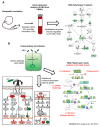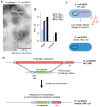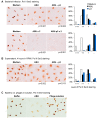Bacterial Suppression of RNA Polymerase II-Dependent Host Gene Expression
- PMID: 27420101
- PMCID: PMC5039429
- DOI: 10.3390/pathogens5030049
Bacterial Suppression of RNA Polymerase II-Dependent Host Gene Expression
Abstract
Asymptomatic bacteriuria (ABU) is a bacterial carrier state in the urinary tract that resembles commensalism at other mucosal sites. ABU strains often lack the virulence factors that characterize uropathogenic Escherichia coli (E. coli) strains and therefore elicit weak innate immune responses in the urinary tract. In addition, ABU strains are active modifiers of the host environment, which they influence by suppressing RNA polymerase II (Pol II)-dependent host gene expression. In patients inoculated with the ABU strain E. coli 83972, gene expression was markedly reduced after 24 h (>60% of all regulated genes). Specific repressors and activators of Pol II-dependent transcription were modified, and Pol II Serine 2 phosphorylation was significantly inhibited, indicating reduced activity of the polymerase. This active inhibition included disease-associated innate immune response pathways, defined by TLR4, IRF-3 and IRF-7, suggesting that ABU strains persist in human hosts by active suppression of the antibacterial defense. In a search for the mechanism of inhibition, we compared the whole genome sequences of E. coli 83972 and the uropathogenic strain E. coli CFT073. In addition to the known loss of virulence genes, we observed that the ABU strain has acquired several phages and identified the lytic Prophage 3 as a candidate Pol II inhibitor. Intact phage particles were released by ABU during in vitro growth in human urine. To address if Prophage 3 affects Pol II activity, we constructed a Prophage 3 negative deletion mutant in E. coli 83972 and compared the effect on Pol II phosphorylation between the mutant and the E. coli 83972 wild type (WT) strains. No difference was detected, suggesting that the Pol II inhibitor is not encoded by the phage. The review summarizes the evidence that the ABU strain E. coli 83972 modifies host gene expression by inhibition of Pol II phosphorylation, and discusses the ability of ABU strains to actively create an environment that enhances their persistence.
Keywords: RNA polymerase II; asymptomatic bacteriuria; gene expression; phages; transcriptional modulation.
Conflict of interest statement
The authors declare no conflict of interest.
Figures




Similar articles
-
Bacterial control of host gene expression through RNA polymerase II.J Clin Invest. 2013 Jun;123(6):2366-79. doi: 10.1172/JCI66451. J Clin Invest. 2013. PMID: 23728172 Free PMC article.
-
Comparison of asymptomatic bacteriuria Escherichia coli isolates from healthy individuals versus those from hospital patients shows that long-term bladder colonization selects for attenuated virulence phenotypes.Infect Immun. 2012 Feb;80(2):668-78. doi: 10.1128/IAI.06191-11. Epub 2011 Nov 21. Infect Immun. 2012. PMID: 22104113 Free PMC article.
-
Characterization of Asymptomatic Bacteriuria Escherichia coli Isolates in Search of Alternative Strains for Efficient Bacterial Interference against Uropathogens.Front Microbiol. 2018 Feb 14;9:214. doi: 10.3389/fmicb.2018.00214. eCollection 2018. Front Microbiol. 2018. PMID: 29491858 Free PMC article.
-
Asymtomatic Bacteriuria as a Model to Study the Coevolution of Hosts and Bacteria.Pathogens. 2016 Feb 15;5(1):21. doi: 10.3390/pathogens5010021. Pathogens. 2016. PMID: 26891332 Free PMC article. Review.
-
Escherichia coli, fimbriae, bacterial persistence and host response induction in the human urinary tract.Int J Med Microbiol. 2005 Oct;295(6-7):487-502. doi: 10.1016/j.ijmm.2005.07.008. Int J Med Microbiol. 2005. PMID: 16238023 Review.
Cited by
-
Epigenetic Mechanisms Regulate Innate Immunity against Uropathogenic and Commensal-Like Escherichia coli in the Surrogate Insect Model Galleria mellonella.Infect Immun. 2017 Sep 20;85(10):e00336-17. doi: 10.1128/IAI.00336-17. Print 2017 Oct. Infect Immun. 2017. PMID: 28739824 Free PMC article.
-
Asymptomatic Bacteriuria in Kidney Transplant Recipients-A Narrative Review.Medicina (Kaunas). 2023 Jan 19;59(2):198. doi: 10.3390/medicina59020198. Medicina (Kaunas). 2023. PMID: 36837399 Free PMC article. Review.
-
MicroRNAs regulate innate immunity against uropathogenic and commensal-like Escherichia coli infections in the surrogate insect model Galleria mellonella.Sci Rep. 2020 Feb 13;10(1):2570. doi: 10.1038/s41598-020-59407-3. Sci Rep. 2020. PMID: 32054914 Free PMC article.
-
Macrophages Infected by a Pathogen and a Non-pathogen Spotted Fever Group Rickettsia Reveal Differential Reprogramming Signatures Early in Infection.Front Cell Infect Microbiol. 2019 Apr 10;9:97. doi: 10.3389/fcimb.2019.00097. eCollection 2019. Front Cell Infect Microbiol. 2019. PMID: 31024862 Free PMC article.
-
Recurrent urinary tract infection genetic risk: a systematic review and gene network analysis.Int Urogynecol J. 2024 Feb;35(2):259-271. doi: 10.1007/s00192-023-05671-6. Epub 2023 Nov 2. Int Urogynecol J. 2024. PMID: 37917182
References
-
- Zdziarski J., Brzuszkiewicz E., Wullt B., Liesegang H., Biran D., Voigt B., Gronberg-Hernandez J., Ragnarsdottir B., Hecker M., Ron E.Z., et al. Host imprints on bacterial genomes-rapid, divergent evolution in individual patients. PLoS Pathog. 2010;6 doi: 10.1371/journal.ppat.1001078. - DOI - PMC - PubMed
LinkOut - more resources
Full Text Sources
Other Literature Sources

